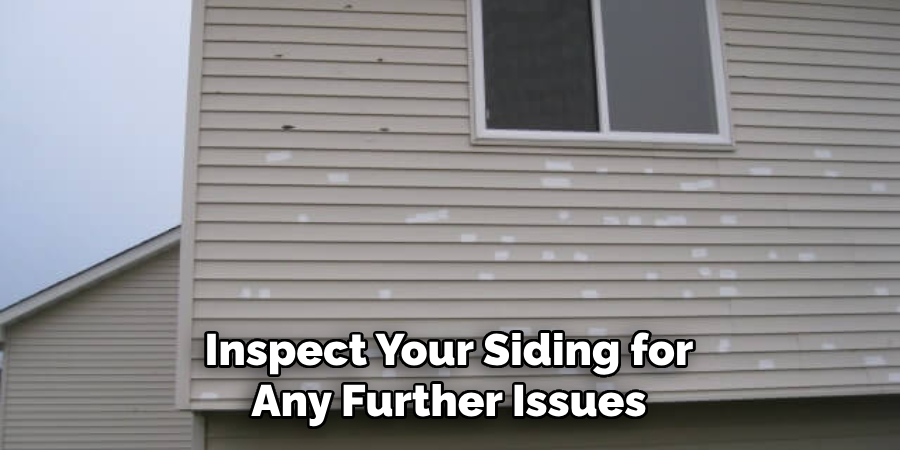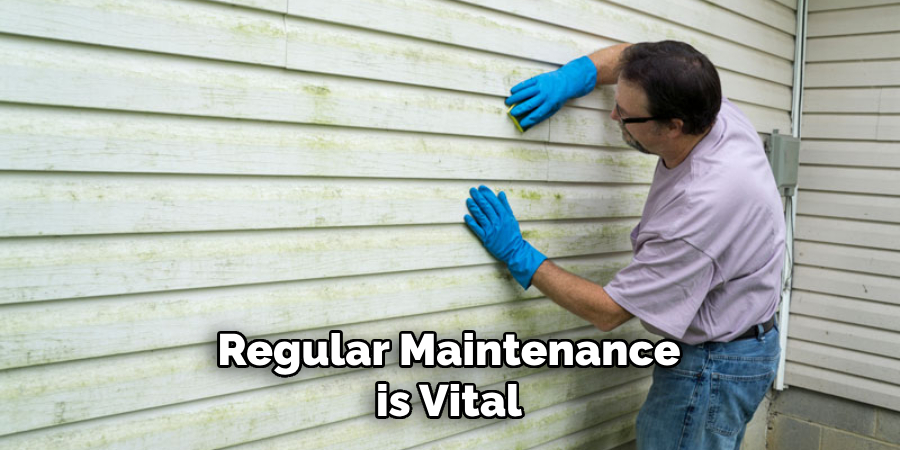Do you have warped siding in your home and don’t know what to do? We understand how frustrating this can be, especially considering the critical role of siding in protecting your home from extreme weather conditions.

Siding is a great way to protect your home from the elements, but it can occasionally become warped due to weather or other factors. Warped siding not only looks unsightly, but it doesn’t offer adequate protection for your home either if you’re looking for a cost-effective way to fix warped siding quickly and easily, read on to learn more about our tried-and-tested approach!
In this blog post, we’ll discuss how to fix warped siding and help restore it to its original condition. Whether you’ve recently noticed that some of your siding has been warped, or you just want to be preemptive by learning what steps are necessary for repair in the future, this guide will provide all the information you need!
Necessary Items for Fixing Warped Siding
Before we dive into the steps for fixing warped siding, it’s essential to make sure you have all of the necessary items on hand. This will save you time and frustration in the long run. Here are some items that you may need:
- Hammer
- Pry bar
- Level
- Nails/screws
- Caulk gun
- Weather-proof caulk (if your siding is made from wood)
- Replacement boards (if needed)
10 Steps on How to Fix Warped Siding
Step 1: Remove Any Damaged or Old Siding
The first step in fixing warped siding is removing damaged or old pieces. Use a pry bar and hammer to carefully remove the pieces without causing further damage. You can also use a heat gun to soften the siding and make it easier to remove. Remember to wear gloves and safety goggles for protection.

Step 2: Inspect the Underlying Structure
Once you have removed the damaged pieces, take a moment to inspect the underlying structure. Make sure no rot or water damage may have caused the warping in the first place. If there is any damage, address it before continuing with repairs.
Step 3: Clean and Prep the Area
Before installing new siding, clean and prep the area where the warped siding was removed. This will ensure proper adhesion of new pieces and prevent any issues in the future. Use a pressure washer or mild soap and water to clean the area, and let it dry completely before proceeding.
Step 4: Measure and Cut Replacement Pieces
Take precise measurements of the area where the warped siding was removed. Use these measurements to cut replacement pieces that will fit perfectly in place. If you’re using wood siding, treat it with a water-resistant sealant before installing.
Step 5: Install New Siding Pieces
Using a level, ensure that the replacement pieces are straight before securing them in place with nails or screws. Sometimes, you may need a caulk gun and weather-proof caulk to fill gaps between the new piece and the existing siding for added protection against moisture.
Step 6: Secure Loose Siding
If you notice any other areas of your siding that are loose or starting to warp, use screws or nails to secure them in place. This will help prevent future warping and maintain the structural integrity of your siding.
Step 7: Inspect for Any Further Issues
After completing the repairs, take a moment to inspect your siding for any further issues thoroughly. Address any additional problems before moving on to the next steps.

Step 8: Paint or Stain Your Siding (Optional)
If you’d like, now is a great time to paint or stain your siding for added protection and aesthetic appeal. Just make sure to choose a weather-resistant product that will hold up well against the elements.
Step 9: Regularly Maintain Your Siding
To prevent warping and other issues with your siding in the future, it’s essential to maintain it regularly. This includes cleaning it at least once a year and addressing any damaged or loose pieces as soon as you notice them.
Step 10: Consider Professional Help
If you need more time to tackle this project, seek professional help. Hiring a reputable contractor can save you time and ensure the job is done correctly.
Fixing warped siding may seem daunting, but with the right tools and knowledge, it can be easily accomplished. Following these steps, you can restore your siding to its original condition and protect your home for years.
Remember to regularly maintain your siding and address any issues as soon as they arise to prevent future warping. And if you ever need help, don’t hesitate to call a professional! Your home’s siding is a significant investment, so it’s worth taking the extra steps to keep it in top shape.
So don’t let warped siding ruin the appearance and functionality of your home – take action today and fix it with these simple steps!
8 Additional Tips for Maintaining Siding
1. Trim Any Nearby Trees or Bushes
Overgrown trees or bushes can cause damage to your siding, so it’s essential to keep them trimmed and away from your home. This will prevent branches or foliage from rubbing against your siding and causing wear and tear.

2. Clean Your Gutters Regularly
Clogged gutters can cause water to overflow onto your siding, leading to potential warping and other issues. Be sure to clean your gutters at least once a year to prevent this from happening.
3. Inspect for Pests
Pests like termites can wreak havoc on your home’s siding, so it’s essential to inspect for any signs of infestation regularly. If you do find pests, be sure to address the issue immediately before they cause severe damage.
4. Check for Any Signs of Moisture Damage
Regularly inspect your siding for any signs of moisture damage, such as mold or rot. Addressing these issues promptly can prevent further damage and save you money in the long run.
5. Pressure Wash Annually
Pressure washing your siding annually is a great way to remove built-up dirt and grime, keeping your siding looking new. Be sure to use a mild detergent and the appropriate pressure setting for your specific type of siding.
6. Repair Any Cracks or Holes
Small cracks or holes in your siding can quickly become more significant problems if left untreated. Regularly inspect and repair any damage to prevent it from spreading.
7. Protect Siding From Extreme Weather
If you live in an area with extreme weather conditions, take extra precautions to protect your siding. This may include installing storm shutters or using impact-resistant materials.
8. Consider Regular Maintenance Services
For busy homeowners needing more time for regular maintenance tasks, consider hiring a professional company to provide regular upkeep for your siding. This can save you time and ensure your siding is always in top condition.
Remember, regular maintenance is vital to preventing costly repairs in the future. Your home’s siding may be durable, but it still requires proper care and attention to maintain its appearance and functionality. Following these tips, you can keep your siding looking great for years!

Fixing warped siding may seem daunting, but with the proper knowledge and tools, it can be easily accomplished. Regularly maintaining your siding is essential for preventing warping and other issues in the future. If you ever need help or feel uncomfortable tackling this project independently, call a professional for assistance.
Frequently Asked Questions
How Do I Know if My Siding Needs to Be Replaced?
Signs that your siding may need to be replaced include warping, cracking, rotting, and mold growth. If you notice any of these issues, it’s best to address them promptly before they cause further damage.
Can Warped Siding Be Fixed Without Replacing It Entirely?
In some cases, yes. Small warping areas may be repaired by securing the loose pieces and filling gaps with caulk. However, severe warping or extensive damage may require replacement of the affected area or even the entire siding.
How Often Should I Clean My Siding?
It’s recommended to clean your siding at least once a year to prevent dirt and grime buildup. However, if you live in an area with heavy precipitation or many trees, you may need to clean it more frequently. It’s also important to regularly inspect your siding for any signs of damage or issues that may require cleaning.
Is Professional Help Necessary for Fixing Warped Siding?
It depends on the severity of the warping and your comfort level with DIY projects. If the warping is minimal, you can fix it independently with the right tools and knowledge. However, severe warping or extensive damage may require professional assistance for best results. Ultimately, it’s crucial to prioritize safety and do what feels most comfortable for you.
Final Thoughts
In conclusion, repairing warped siding can be complex and time-intensive, but it is worth the effort. The process starts with diagnosing the cause of the warping and then choosing either repair or replacement.
To perform the correct fix, removal and sizing tools such as sanders, nippers, jigsaws, cold chisels, and pry bars can safely remove and install new siding materials. Doing so requires great patience and attention to detail to effectively restore the condition of a building’s exterior.
If you’re still feeling lost after walking through these steps, it may be beneficial to hire a professional for assistance. Ultimately, by taking appropriate safety precautions like wearing protective eyewear and gloves while following instructions on how to fix warped siding, anyone should feel confident to tackle this siding repair project! So don’t delay—take action today to ensure your home looks its best and functions properly!
